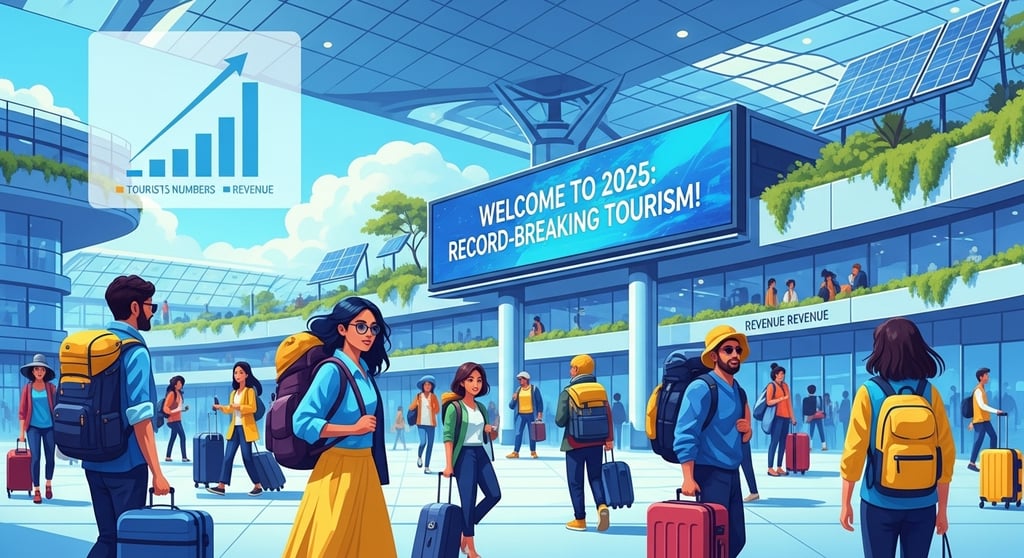Record-Breaking Tourist Arrivals in 2025: Tackling the Revenue Challenge
Discover how record-breaking tourist arrivals in 2025 are boosting global tourism recovery, yet posing revenue challenges for the industry. Explore trends, factors, and strategies for sustainable growth in post-pandemic travel


Introduction
In 2025, the world is witnessing record-breaking tourist arrivals, surpassing even pre-pandemic levels in many regions. According to the latest data from UN Tourism, international arrivals grew by 5% in the first quarter compared to 2024, reaching 3% above 2019 figures. This surge signals a robust global tourism recovery, driven by pent-up demand and easier travel restrictions. However, amid this boom, the industry faces a significant revenue challenge: high volumes of visitors but lower profit margins. For travelers, students, and professionals alike, understanding this dynamic is key to navigating the evolving landscape of post-pandemic tourism trends.
The Surge in Global Tourist Arrivals
The travel sector has rebounded impressively since the COVID-19 era. In 2024, international tourist arrivals nearly fully recovered to 99% of 2019 levels, with about 1.4 billion cross-border trips. Building on this, 2025 projections from UN Tourism indicate a further 3% to 5% growth over 2024. Regions like Europe and the Middle East are leading the charge, with countries such as Turkey, Italy, and Greece reporting increases in visitor numbers and spending.
This growth is fueled by several factors. Affordable airfares, thanks to competitive airline pricing, have made international travel more accessible. Additionally, the rise of remote work has encouraged longer stays and "bleisure" trips—blending business and leisure. For instance, Asia-Pacific markets are seeing a resurgence, though challenges like currency fluctuations persist. Overall, these record-breaking tourist arrivals highlight a resilient industry adapting to new traveler preferences, such as experiential and eco-friendly journeys.
Understanding the Revenue Challenge in Tourism
Despite the influx of tourists, revenue isn't keeping pace with arrivals. The travel industry is experiencing a "high volume, low margin" scenario, where global EBITDA (earnings before interest, taxes, depreciation, and amortization) remains 15% below 2019 levels. In the U.S., for example, international visitor spending is projected to drop to under $169 billion in 2025, down from $181 billion in 2024, amid an 8.2% decline in arrivals.
This revenue challenge stems from a mismatch between visitor numbers and per-person spending. While more people are traveling, many opt for budget options, leading to compressed profits for hotels, airlines, and online travel agencies (OTAs). Major players like Booking Holdings and Expedia have reported declining EBITDA margins—36.6% and 9.9%, respectively—in recent quarters. For smaller operators, this means tighter budgets and the need for innovative ways to capture value.
Key Factors Contributing to Lower Travel Industry Margins
Several elements are driving the revenue shortfall amid record-breaking tourist arrivals. First, intense competition has led to discounting. Airlines and hotels are slashing prices to fill seats and rooms, reducing net revenue per booking. For air travel, margins are down 15% from 2019, while lodging sees a 10% drop.
Second, consumer behavior has shifted. Shorter booking windows—now averaging 55 nights in advance versus 65 in 2019—create uncertainty and increase marketing costs. Travelers also favor flexible, refundable options, which can erode profits. Regional issues, such as slower recovery in China's outbound market and economic pressures in North America, exacerbate the problem.
Finally, operational costs are rising. Fuel prices, labor shortages, and sustainability mandates add expenses without proportional revenue gains. In states like California, tourism forecasts predict a decline after record years, with overall U.S. tourism risking billions in lost revenue.
Strategies to Boost Revenue in a High-Volume Market
To address the revenue challenge, industry stakeholders are adopting smart tactics. One approach is upselling ancillaries, like premium seats or experiences, which have shown 5-10% growth in margins. AI-driven pricing tools can optimize rates in real-time, potentially increasing revenue by 22%.
Another strategy involves dynamic packaging—bundling flights, hotels, and activities—to enhance value and conversions. Platforms like Airbnb have boosted bookings by 30% through in-destination offerings. Sustainable tourism practices, such as eco-certifications, appeal to conscious travelers and justify premium pricing.
For beginners in the industry, starting with data analytics is crucial. Tools like Google Analytics or travel-specific platforms (e.g., TripAdvisor's insights) help track trends. Embedding finance options, like buy-now-pay-later (BNPL), can also lift average spend.
Conclusion
Record-breaking tourist arrivals in 2025 mark a triumphant global tourism recovery, with projections of 3-5% growth signaling sustained momentum. However, the accompanying revenue challenge—characterized by low margins and shifting consumer habits—demands adaptive strategies. Key takeaways include recognizing the high-volume, low-margin dynamic, addressing factors like discounting and operational costs, and leveraging tools for upselling and personalization.
Looking ahead, future trends point to AI integration for smarter planning and sustainable practices to ensure long-term viability. As the industry evolves, travelers and professionals can benefit from these insights to make informed decisions. What steps will you take to navigate this exciting yet challenging era in travel? Share your thoughts below to join the conversation.
(Word count: 852)
FAQs
What Are the Main Reasons for Record-Breaking Tourist Arrivals in 2025?
Record-breaking tourist arrivals in 2025 are driven by affordable airfares, eased restrictions, and the rise of remote work enabling longer trips. UN Tourism reports a 5% increase in Q1 2025 over 2024, exceeding pre-pandemic levels by 3%.
Why Is There a Revenue Challenge Despite High Tourist Numbers?
The revenue challenge arises from lower per-person spending and compressed margins. Global EBITDA is 15% below 2019 levels, with OTAs facing flat net revenues per booking due to discounting and shorter lead times.
How Can the Travel Industry Overcome Low Margins in Post-Pandemic Tourism Trends?
To overcome low margins, focus on AI pricing, ancillary upselling, and dynamic bundling. These strategies can boost revenue by up to 22%, as seen in successful platforms like Airbnb.
What Future Trends Will Shape Global Tourism Recovery?
Future trends include AI tools for personalized travel planning and sustainable practices. Expect growth in eco-tourism and tech integrations, helping address revenue challenges while meeting traveler demands.
Are There Recommended AI Tools for Travelers Facing Revenue Challenges in Booking?
Yes, tools like Kayak or Google Flights use AI for budget optimization, while Expedia's app offers personalized deals to maximize value amid industry revenue pressures.
